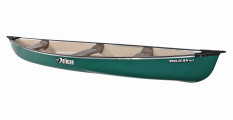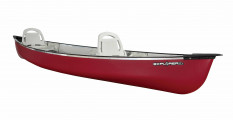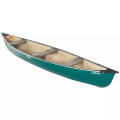Pelican Sport may be best known for the affordable recreational kayaks found in the aisles of big box stores and on quiet cottage lakes, but they also produce a line of plastic canoes that fit a similar market niche. Due to their beginner-friendly design and reasonable price, you can find canoes from Quebec-based Pelican Sport on waters across the continent.
These affordable canoes are best used for short outings on flat waters. You can cast a line on a calm lake and fish from a Pelican without being overly worried about capsizing. The wide design of these canoes helps them travel steadily but slowly along the water. Their heavy-duty RAM-X plastic hulls can take a beating while requiring minimal maintenance.
The three-seat design on Pelican canoes eliminates the yoke (the bar running across the center of the canoe that’s used for portaging). That’s an important factor to consider when envisioning how the canoe will be used. Is extra seating or the ability to portage more important to you?
A Pelican is a decent option if you are looking for an entry-level canoe for tranquil day outings. Backcountry trippers or paddlers who want to move quickly may want to look at other boats that use composite materials and have more performance-oriented designs. They will be more expensive though, as Pelican canoes are some of the cheapest new boats you can buy.
This article will help you decide which Pelican canoe is right for you. We also provide links to our Paddling Buyer’s Guide, where you can compare Pelican canoes alongside other brands. Read on to learn more.
Top picks: Best Pelican canoes for 2025
The following Pelican canoes have received the highest star ratings by reviewers in our Paddling Buyer’s Guide. See and review all Pelican canoes here.
Best Pelican Canoes

Pelican 15.5
Shop Pelican canoes
If you’re ready to start browsing, use the links below to view all of Pelican’s canoes in our Paddling Buyer’s Guide. This comprehensive resource has information on nearly every canoe on the market, including Pelican’s. Here, you can compare models and view important information like dimensions, weight and prices. You’ll also have access to reviews that provide further insight into each boat.
Use the filtered links to begin searching by type, size, material or stores where they’re available.
Shop by type
Shop by size
Shop by material
Shopping for a used Pelican canoe?
Picking up a used Pelican canoe minimizes your financial commitment. These are budget boats to begin with, and a used one will cost you even less. There are some important things to look out for, particularly any damage.
The RAM-X material that Pelican uses to make their canoes is extremely resilient, but when it breaks, fixing it isn’t easy. Plastic canoes tend to show lots of minor scrapes and abrasions, and the majority of these are superficial and won’t compromise the hull. Any large gouges are hard to repair and can be cause for concern.
You’ll also want to inspect the canoe’s hardware thoroughly. Ensure that the bolts fastening the gunwales to the hull are all intact and that the seats themselves aren’t cracked or warped. Some older Pelican canoes have issues at the connection points between the seats and the hull, and replacements may be difficult to find. Check this point closely on all three seats.
Standard used canoe pricing would suggest these canoes sell for around half of their original price. With disruptions in production and increased paddlesports demand, the prices of used canoes have surged. Some Pelican canoes are listed for nearly the same price they would sell for new—or even higher!
Don’t indulge the scalpers, give these a pass. If you’re going to pay a premium on a used canoe, hold out and buy a higher-end one, probably for around the same price. Or, if you’re set on a Pelican, buy a new one that will come with the assurance of quality control and a five-year warranty.
For more tips on what to look for when selecting a used canoe, read our article How To Buy A Used Canoe.
Pelican canoe buying advice
If you’re considering the purchase of a Pelican canoe, consider the type of paddling you plan to do and what these canoes are suitable for. You want to get a canoe that aligns with your goals. If not, you run the risk of outgrowing the boat quickly, and finding yourself canoe shopping once again.
Pelican canoes are intended to be used casually. They’re classified as recreational canoes, notable for their wide, flat hull shape. These stable canoes are beginner-oriented and best-suited for calm waters. Without a portage yoke, these canoes need to be carried upright by two people. This method is not ideal for long portages. You’ll enjoy these boats most on a continuous river or lake system.
Materials
All Pelican canoes are built with RAM-X, a type of polyethylene with a high molecular weight (HMWPE). This is different from high-density polyethylene (HDPE), another plastic commonly used to make canoes or kayaks. RAM-X has a high structural memory, meaning it will revert to its original shape after impacts. A large company like Pelican can produce these boats at a low cost, bringing the price down for consumers.
The downside of RAM-X is that the material is tough to repair and heavy. Traditional methods of plastic-welding that work well on T-Formex or HDPE canoes don’t bond as well to RAM-X. Fortunately, repairs are rarely necessary.
Canoes made with plastics like RAM-X, T-Formex, or other polyethylenes are generally heavier than composite canoes made with fiberglass or ultralight materials like Kevlar. Composites are also more rigid, making them more responsive on the water.
Seating systems
Depending on the model, Pelican canoes either come with folding stadium-style seats or molded-in bench seats. The Explorer 14.6 DLX has two folding seats in the bow and stern. The backrests may make sitting in the canoe for a short outing comfortable, although they restrict mobility and prevent paddlers from engaging their torso and core while paddling.
For a half-hour paddle off the dock, you probably won’t notice it, but there’s a reason tripping canoes use the low-profile bench or bucket seats. In the middle of the Explorer 14.6 DLX is a third seat that also serves as a cooler. This seat resembles the ones found on the longer Pelican 15.5.
The seats in the middle of the Explorer 14.6 and the Pelican 15.5 are bench seats. You’ll find some iteration of bench seats on most canoes on the market. Traditionally, they are made from wood, with cane, sinew or webbing woven across the frames. Pelican’s seats are made of heavy plastic.
Lengths
The Explorer 14.6 is the shorter of Pelican’s two canoes, at 14’6’’. It’s easy to transport and store this shorter canoe. It will turn more readily than the longer Pelican 15.5, but the latter will track (move in a straight line) better. Both of these canoes are relatively short for multi-paddler boats, but if you are not carrying gear and food for extended camping trips, the lack of length is not a concern.
These are a good size for day tripping, and three paddlers will fit comfortably in the Pelican 15.5. The Explorer 14.6 is better for two adults and a child in the middle.
-
Are Pelican canoes reliable?
Pelican canoes are reliable for extremely light recreational outings. Their thermoformed plastic hulls can withstand repeated impacts, although repairs are difficult should they be required.
-
Pelican canoe models
Pelican presently has three canoe models listed on their website: the Explorer 14.6 DLX, Dakota, and Pelican 15.5. The Pelican 15.5 is sold as the Dakota in the USA; the two canoes are identical.
-
What are Pelican canoes made out of?
Pelican canoes are made out of RAM-X material. This is a high molecular weight polyethylene (HMWPE), a strong plastic that can handle impacts and abrasions. They are made by heating sheets of HMWPE and shaping them into the correct figure with a mold. This process is called thermoforming.
Polyethylene canoes are some of the heaviest but most durable canoes. The process and materials are relatively inexpensive, keeping the overall cost of the canoes low.
-
Pelican canoe weight
Polyethylene canoes like Pelicans are heavy for their size. The Pelican 15.5 weighs 81 pounds, while most 15.5-foot composite canoes will be 60 pounds or less.
-
Pelican canoe weight limit
Both Pelican canoes have listed weight limits of 800 pounds. Actual weight limit may vary depending on the distribution of weight in the canoe and the weather conditions.
-
Pelican canoe prices
The low price is the most attractive draw to a Pelican canoe, and you can get any of their canoes for under $1,000.
-
Where are Pelican boats manufactured?
Pelican boats are manufactured in Canada.
-
Who owns Pelican boats?
Pelican Sport operates as part of Pelican International Inc. Other groups owned by Pelican International include Confluence Outdoors, which is the group responsible for popular paddling brands like Dagger, Perception, Mad River and Wilderness Systems.
-
Are Pelican and Pelican Sport the same company?
There are two plastics manufacturers with the name “Pelican” in North America. Pelican Sport makes canoes, kayaks, standup paddleboards and other watercraft. Pelican is also the name of a company that makes rugged plastic cases, coolers and travel kits. They are different companies, as Pelican Sport is Canadian and Pelican is based in California.
Compare Pelican canoes
-
Pelican vs Old Town Canoes
Old Town is another canoe manufacturer that specializes in making affordable canoes. They are one of America’s oldest canoe builders, with more than 100 years of experience that began with wood canvas canoes in 1898. They now build canoes using single- or three-layer polyethylene.
Old Town has an extensive line of canoes, from solo canoes under 12 feet up to tripping boats like the 17-foot Penobscot 174. These canoes follow more traditional designs, with yokes for portaging and storage for multi-day excursions. Some of their solo canoes, like the Next, have kayak-style seats where the paddler sits lower in the canoe for extra stability. These can be paddled with canoe paddles or a double-bladed kayak paddle. Old Town’s canoes outrank Pelican canoes in quality and performance, but Pelican canoes are cheaper for the most part.
Pelican canoes are also easier to find. You’ll see them adorning the floors of many different big-box stores, and they can even be ordered on Amazon. Old Town canoes are sold at dedicated paddlesport retailers and outdoor stores like Dick’s Sporting Goods. They sell a bit quicker, but if you can find them, they are the better choice for only a little more money.
Pelican canoe reviews
Read reviews by our expert staff to gain more insight into how these boats perform. These are one of the best ways to understand how a canoe actually handles—short of paddling it yourself.









